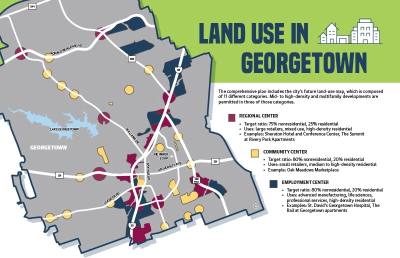One factor driving the city’s future land-use map is that Georgetown’s population is expected to exceed 100,000 by 2030—growing 44.4% since 2022—according to the plan and data from the U.S. Census Bureau.
There are 20 multifamily complexes under construction and more commercial projects underway in the plan’s targeted areas for density such as Williams Drive and NE Inner Loop.
“As we continue to grow, our patterns will shift, and the future land-use element in the plan helps guide those development patterns,” said Nat Waggoner, assistant long-range planning director.
Mapping it out
The comprehensive plan, which was adopted in 2020, identifies 11 land-use categories—such as neighborhoods, community centers, and parks and recreation—that make up the city’s future land-use map, or FLUM. According to the plan, the FLUM and its categories serve as the city’s long-range roadmap to establish an overall framework for the preferred development pattern of the city based on balanced, compatible and diversified land uses.
Waggoner said before updating the plan, high-density residential was a standalone use. Now, it will exist within the future land-use categories of employment center, community center and regional center, which could benefit both developers and residents.
“What we heard from the community is that they want to have more complete neighborhoods—and we recognize multifamily is a neighborhood in some regards—so we wanted to make sure that folks living in those developments have access to goods and services,” Waggoner said.
According to the plan, the city aims to have 75% nonresidential and 25% residential development within a regional center. This ratio allows developments such as major shopping centers, big-box retailers and flex office space to exist in close proximity to residential buildings, which encourages the interaction of residents and businesses, according to the plan.
The Sheraton Hotel and Conference Center at 1101 Woodlawn Drive and The Summit at Rivery Park Apartments are examples of a regional center development.
Similarly, an employment center should have a ratio of 80% nonresidential and 20% residential development. Including moderate- to high-density residential in these areas is intended to support the employers.
St. David’s Georgetown Hospital and The Rail at Georgetown apartments are in an employment center.
“Population growth and housing affordability has created an increased demand for alternatives to low-density, single-family housing,” said Cesar Acosta, Georgetown’s long-term planning director. “Including employment and regional centers in the plan has been helpful in providing us with a transition.”
Working on Williams Drive
The plan encourages redevelopment in key areas such as Williams Drive.
The Williams Drive Study, which was drafted in 2017 by the Capital Area Metropolitan Planning Organization and the city, focuses on a 558-acre area along Williams Drive between San Gabriel Park and Lakeway Drive. Waggoner said the vision is to create a vibrant mixed-use center and gateway.
Because the study emphasizes traffic flow, the city is working to submit a request for proposal to engineers to conduct an access management study that will propose the removal and repositioning of driveways along Williams.
According to the plan, other areas of concern include pedestrian accessibility, consistent signage and branding, mixed-use infrastructure, and modern accents and characteristics.
One redevelopment project in the works is the former McCoy Elementary School property, a 12-acre site purchased by Partners Capital in December. Located at 1313 Williams Drive, the building housed Georgetown ISD administrative staff when the new McCoy school was built. In 2018, staff moved to the Hammerlun Center for Leadership and Learning, leaving the former school vacant. Demolition was approved in March 2019.
A press release from Partners Capital said the real estate firm is planning to build a mixed-use development with multifamily residential and commercial buildings that will house retail stores, medical offices and restaurants.
“Williams Drive is a major thoroughfare for the city,” Waggoner said. “Efforts to develop the Williams Drive Study and the 2030 Comprehensive Plan included public outreach and community conversation.”
Affordability and availability
The ApartmentData.com June report shows there are approximately 23,995 multifamily units in the Round Rock and Georgetown submarket.
“Due to buyer fatigue, rising interest rates and general price increase, people are not really certain on what is the best way to spend their money,” said Brandy Wuensch, 2022 Austin Board of Realtors secretary-treasurer. “This is turning buyers to look into ... alternatives to single-family.”
An estimated 5,500 multifamily units were submitted to the city of Georgetown for approval from October 2021 to June 2022. Radius Wolf Ranch, a 321-unit complex at 1845 W. University Ave., was recently approved.
“Our timing to deliver couldn’t come soon enough,” said Matt Akin, president of McCann Realty Partners. “It’s very expensive out there for people trying to find affordable options.”
According to ApartmentData.com, the June 2022 median rent in the Georgetown and Round Rock submarket is $1,558—$20 more than the Pflugerville and Tech Ridge submarket.
“It is difficult for us to guide or significantly impact the cost of housing,” Acosta said.
The city is looking into updating its development code to align it with the 2030 plan, Waggoner said. Additionally, the city may consider programs such as down payment assistance and multifamily tax exemptions.
“We want to be able to support people from all backgrounds that chose to make Georgetown their home,” Acosta said.







